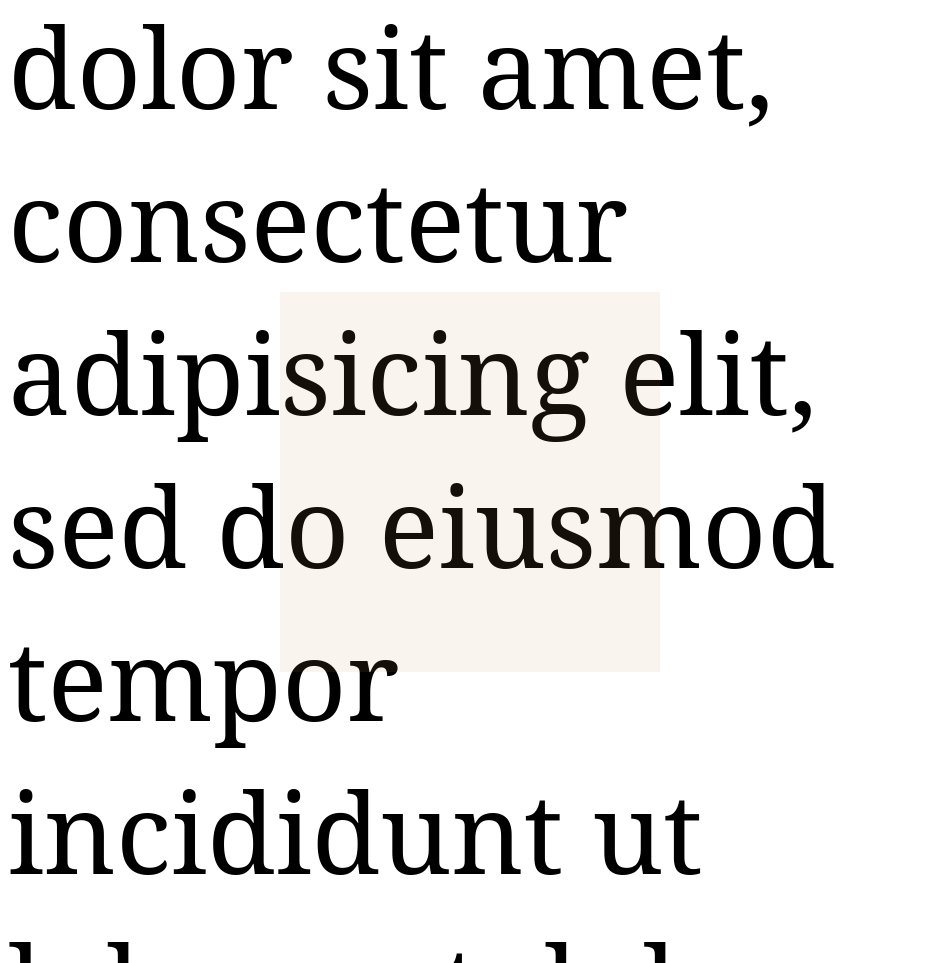JavaScript¶
JavaScript is a programming language made to change the appearance or behaviour of a web site. Code is stored in plain text files with the file ending .js or included into an HTML file with the <script> tag. For the latter it’s recommended to insert the script at the bottom of the page, above the closing </body> tag.
JavaScript is executed through the browser. You can test code snippets through the inspector tool or with a sandbox like JSFiddle.
index.html
<!DOCTYPE html>
<html>
<head>
<meta name="viewport" content="width=device-width, initial-scale=1.0">
<style>
#object {
width: 40vw;
height: 40vw;
background-color: rgb(235, 132, 66);
position: fixed;
top: 50%;
left: 50%;
transform: translate(-50%, -50%);
}
#object:hover {
cursor: pointer;
}
</style>
</head>
<body>
<div id="object" onclick="change_color();"></div>
<script>
function change_color() {
// Return random colors.
var r = Math.floor(Math.random() * 255);
var g = Math.floor(Math.random() * 255);
var b = Math.floor(Math.random() * 255);
// Create a string with the variables r, g and b.
var color = `rgb(${r}, ${g}, ${b})`;
// Change the background color.
document.getElementById("object").style.background = color;
}
</script>
</body>
</html>

Functions¶
On click onto the colored square it’s color will be changed. The function is called through onclick="change_color();". The function is defined through function change_color() { ... }. The word function is a reserved keyword, the name of the function itself is of your choice. Everything inside the {} will be executed when the function is called.
// Syntax
function my_function() {
// Code of the function.
// Code of the function.
}
The block of code to be executed inside the function is indent by a tab. This is done for (human) readability only. It’s possible to place all the code in one line.
Variables¶
The next keyword var defines a variable. A variable can store data (and functions) and this data can change over time. With the help of the built-in random function (Math.floor(Math.random() * 255);) a number between 0 and 255 is generated and assigned to the variables r, g and b.
This values are inserted into a string (text), stored in the variable color. The string follows the CSS command for an rgb value.
With document.getElementById("object").style.background = color; this rgb values will be assigned to the HTML element with the id “object”.

/* Function with alpha channel */
function change_color() {
// Return random colors.
var r = Math.floor(Math.random() * 256);
var g = Math.floor(Math.random() * 256);
var b = Math.floor(Math.random() * 256);
var a = Math.random();
// Create a string with the variables r, g, b and a.
var color = `rgba(${r}, ${g}, ${b}, ${a})`;
// Change the background color.
document.getElementById("object").style.background = color;
}
Primitive Datatypes¶
We’ve seen numbers and text data types in the example above. Here is a full list of primitive datatypes:
Number
var n = 1String
var text = 'some text'Boolean (
trueorfalse)var clicked = falseUndefined
Null
Symbol
var a = 1;
var b = 2;
var c = a+b;
console.log(c); // 3
var a = 'some text';
console.log(a); // some text
var b = 'some text';
var texts_identical = (a === b); // true
console.log(texts_identical);
var e;
console.log(e); // undefined
Number¶
var a = 0;
a++; // Increment by 1. a = 1
a += 4; // a + 4 = 5
var b = a / 2; // b = 2.5
var c = 4 * 3; // c = 12
c = c / 2; // c = 6
c = 6 % 2; // c = 0
c = 5 % 2; // c = 1
c--; //c = 0
String¶
var fox = 'The quick brown fox'; // Declaration with single quotes
var dog = " jumps over the lazy dog."; // Declaration with double quotes
var text = fox + dog;
var len = text.length; // 44
var dog_at_end = text.endsWith('dog.'); // true
var dog_at_start = text.startsWith('dog.'); // false
var number = 13; // 13
var number_toString = number.toString(); // "13"
For booleans see Comparison.
Array¶
An array is a list of items (variables, objects, functions). It’s defined through [] and comma separated values. Commonly arrays are declared with the const keyword (See Scope & var, let, const).
const rgb = [235, 132, 66];
const word_list_1 = ['creative', 'uncreative', 'experimental', 'boring', 'open'];
const word_list_2 = ['code', 'algorithms', 'processes', 'machines'];
// Mixed type arrays are possible.
const arr = [235, 'creative', false, rgb];
console.log(arr); // [235, "creative", false, [235, 132, 66]]
// Override a value.
arr[1] = '(un)creative'; // Arrays start with index 0.
console.log(arr); // [235, "(un)creative", false, [235, 132, 66]]
// Access the first item:
var first = arr[0]; // 235
// Access the last item:
var last = arr[arr.length - 1]; // [235, 132, 66]
// Add an item:
arr.push('new item');
// Sort the array:
arr.sort(); // ["(un)creative", 235, [235, 132, 66], false]
Objects¶
Objects are structured like a dictionary. They contain (multiple) key:value pairs (properties), enclosed by {}.
const headline = {word:'creative', rgb:[235, 132, 66]};
// Access properties:
console.log(headline.word); // 'creative'
console.log(headline.rgb); // [235, 132, 66]
// Or:
console.log(headline['word']); // 'creative'
Scope & var, let, const¶
Scope is the area in which data or a function is available. In general there are three different scopes: global, local and block.
Everything declared outside of a function is global, everything inside local, with one exception: Variables inside a function that are declared without the var keyword.
var a = 'global'; // global variable
function x() {
b = 'global inside function'; // global variable
var c = 'local inside function'; // local variable
}
x(); // execute x
{
let d = 'local inside block';
var e = 'global inside block';
}
console.log('a:' + a) // global
console.log('b:' + b) // global inside function
console.log('c:' + c) // Error: c is not defined
console.log('d:' + d) // Error: d is not defined
console.log('e:' + e) // global inside block
// Variables with var can be redeclared:
var a = 1;
var a = 'word';
// Variables with let not:
let a = 1;
let a = 'word'; // Error
// Variables with const can not be redeclared, but properties of const Arrays or Objects can change.
const a = 1;
const a = 2; // Error
const word_list_1 = ['creative', 'open'];
// Add a value
word_list_1.push('boring');
// Change a value
word_list_1[0] = '(un)creative';
console.log(word_list_1); // ["(un)creative", "open", "boring"]
if¶
// Syntax
if (condition) {
// do this
} else if (condition) {
// do that
} else {
// otherwise do that
}
Comparison¶
1 == '1'; // true
1 === '1'; // false
1 != 1; // false
1 > 0; // true
1 < 0; // false
1 >= 0; // true
1 <= 0; // false
=== checks the value and the type (like number and string above)
== casts the type if necessary and compares then
!- true if not equal
Loops¶
For¶
// Syntax
for (initializer; condition; incrementor) {
// do something for each iteration
}
// Example
for (let i=0; i < 5; i++) {
console.log(i);
}
// Result
0
1
2
3
4
For In¶
Loop over an object.
const headline = {word:'creative', rgb:[235, 132, 66]};
for (let key in headline) {
// get value for key
console.log(headline[key]);
}
// creative
// [ 235, 132, 66]
Loop over an array.
let word_list_2 = ['code', 'algorithms', 'processes', 'machines'];
for (let i in word_list_2) {
console.log(word_list_2[i]);
}
// code
// algorithms
// processes
// machines
For Of¶
Loops through elements of an array or string.
let word_list_2 = ['code', 'algorithms', 'processes', 'machines'];
for (let item of word_list_2) {
console.log(item);
}
// code
// algorithms
// processes
// machines
for (let character of word_list_2[0]) {
console.log(character);
}
// c
// o
// d
// e
Functions – return¶
// Insert data via arguments.
function sum(a, b) {
var res = a+b;
// Return the result.
return res
}
r = sum(2, 7);
console.log(r); // 9
change_position().One possible solution.
function change_color() {
// Change size.
change_size();
// Return random colors.
var r = Math.floor(Math.random() * 255);
var g = Math.floor(Math.random() * 255);
var b = Math.floor(Math.random() * 255);
// Create a string with the variables r, g and b.
var color = `rgb(${r}, ${g}, ${b})`;
// Change the background color.
document.getElementById("object").style.background = color;
}
function change_size() {
var w = Math.floor(Math.random() * 100 + 1).toString() + 'vw';
var h = Math.floor(Math.random() * 100 + 1).toString() + 'vh';
document.getElementById('object').style.width = w;
document.getElementById('object').style.height = h;
}
